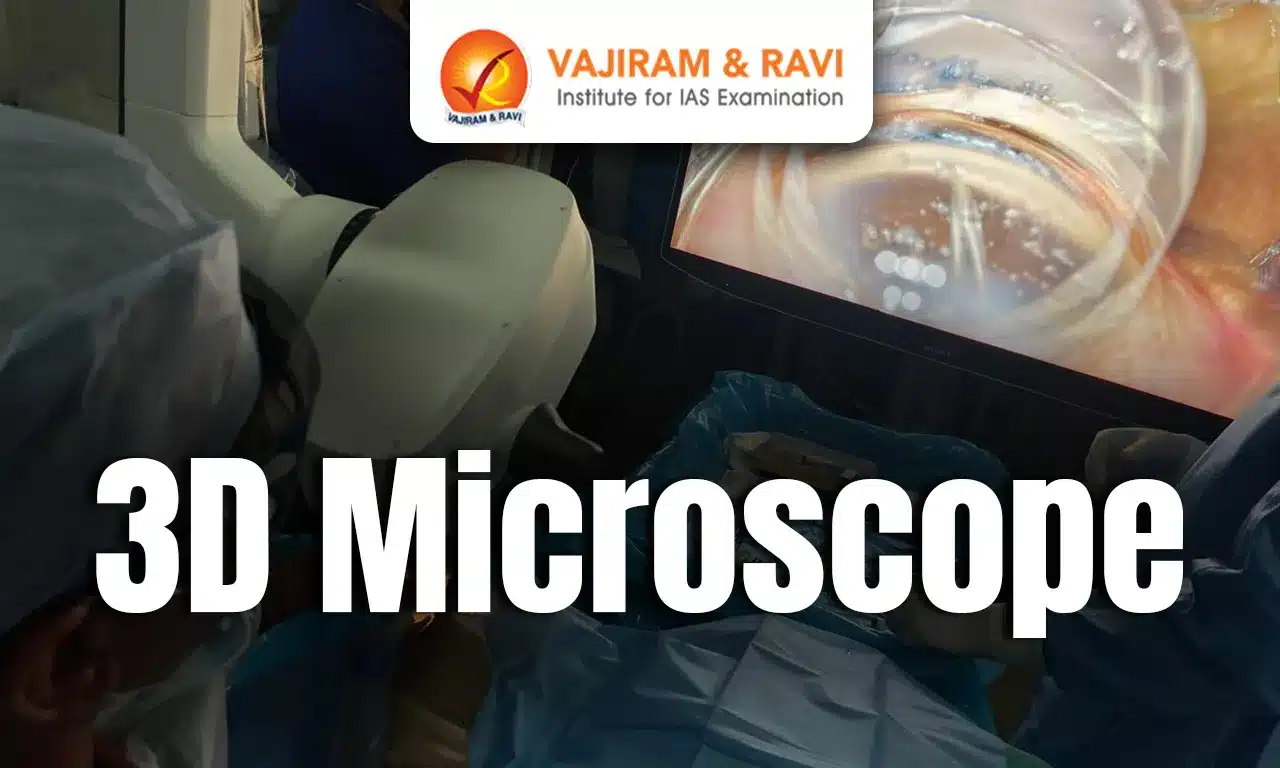3D Microscope Latest News
For the first time, the Indian Army’s Department of Ophthalmology at Army Hospital (Research and Referral), New Delhi, has successfully performed Minimally Invasive Glaucoma Surgery (MIGS) using a 3D Microscope.
What is a Microscope?
- A microscope is an instrument that magnifies small objects, making them visible to the naked eye by bending (refracting) light rays through curved lenses.
- The most commonly used microscopes are optical microscopes, where visible light is focused through lenses to create an enlarged image.
What is a 3D Microscope?
- A 3D microscope produces images with depth information (X, Y, and Z axes), allowing researchers to visualize and measure the topography, volume, and internal structures of samples.
- Unlike traditional light microscopes, which provide flat, 2D images, 3D microscopes use advanced optical, electron, or computational techniques to capture and reconstruct three-dimensional data.
- This is particularly useful for studying complex biological or environmental samples, such as soil microbes, aquatic organisms, or microplastics.
Features of the 3D Microscope
- The 3D Microscope uses advanced three-dimensional visualisation, assisting in complex eye surgeries such as treatment for squint, cataract, corneal diseases, glaucoma, and retinal conditions.
- It employs special 3D polarisation glasses for surgeons and a 55-inch 4K ultra-HD display.
- Key advantages include:
- Reduced surgical time and lower complication rates compared to conventional microscopes.
- Decreased endoilluminator power requirements, thereby reducing photo-toxicity risks.
- Ease of performing surgeries in complex and rare cases.
3D Microscope FAQs
Q1: What is a 3D Microscope?
Ans: A 3D Microscope is an advanced imaging tool that creates three-dimensional, highly detailed visualizations of microscopic samples, enhancing depth perception.
Q2: Which technologies are used in 3D Microscopy?
Ans: Techniques like confocal microscopy, two-photon microscopy, and light-sheet fluorescence microscopy are commonly used for 3D imaging.
Q3: How does a 3D Microscope differ from a traditional microscope?
Ans: Unlike traditional microscopes that provide flat, two-dimensional images, 3D microscopes generate volumetric images that can be rotated and analysed from different angles.
Source: PIB
Last updated on December, 2025
→ Check out the latest UPSC Syllabus 2026 here.
→ Join Vajiram & Ravi’s Interview Guidance Programme for expert help to crack your final UPSC stage.
→ UPSC Mains Result 2025 is now out.
→ UPSC Notification 2026 is scheduled to be released on January 14, 2026.
→ UPSC Calendar 2026 is released on 15th May, 2025.
→ The UPSC Vacancy 2025 were released 1129, out of which 979 were for UPSC CSE and remaining 150 are for UPSC IFoS.
→ UPSC Prelims 2026 will be conducted on 24th May, 2026 & UPSC Mains 2026 will be conducted on 21st August 2026.
→ The UPSC Selection Process is of 3 stages-Prelims, Mains and Interview.
→ UPSC Result 2024 is released with latest UPSC Marksheet 2024. Check Now!
→ UPSC Prelims Result 2025 is out now for the CSE held on 25 May 2025.
→ UPSC Toppers List 2024 is released now. Shakti Dubey is UPSC AIR 1 2024 Topper.
→ UPSC Prelims Question Paper 2025 and Unofficial Prelims Answer Key 2025 are available now.
→ UPSC Mains Question Paper 2025 is out for Essay, GS 1, 2, 3 & GS 4.
→ UPSC Mains Indian Language Question Paper 2025 is now out.
→ UPSC Mains Optional Question Paper 2025 is now out.
→ Also check Best IAS Coaching in Delhi
Tags: 3d microscope prelims pointers upsc current affairs upsc prelims current affairs

















